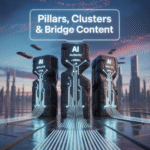Avoiding the “AI Trap”: How to Use Automation Without Losing Your Edge
Automation should feel like freedom. Instead, it becomes a crutch. You build a funnel and stop watching how people move through it.
You schedule content and forget to check if anyone’s responding.
You start to think in templates, not conversations. That’s the AI trap. It’s not that AI isn’t helpful.
It’s that you stop thinking like a marketer and start thinking like a machine. And machines don’t sell.
The people who make the most of AI use it to amplify their edge, not replace it. They write faster but not sloppier. They automate systems, not strategy.
They let AI handle the grunt work so they can focus on the part no tool can do—reading people, adjusting tone, spotting shifts, adapting fast.
But most solo marketers hand everything off and call it leverage. What they’re really doing is tuning out.
You’ll see this with content especially. Someone builds a blog calendar and tells AI to write everything.
The posts are clean, optimized, even helpful—but they don’t move anyone. Because they weren’t written with anyone in mind. No real voice. No heat. No rhythm.
Just technically correct fluff that might rank but never converts.
Or they’ll create a sales funnel that looks good on paper. The lead magnet is catchy, the emails are sequenced, the offer is clear. But conversions are flat.
Because no one tested how it felt to read.
No one rewrote that first email after 1,000 people ignored it. No one tracked what questions buyers asked and built a bonus to solve it. AI can’t do that on its own.
It doesn’t notice nuance. It reacts to prompts. It doesn’t question direction.
Automation works best when it’s paired with attention. If you stop looking at what’s working and what’s not, AI just keeps running broken systems faster.
That’s how you lose your edge.
You stop listening. You stop optimizing. You stop adjusting based on real signals. And that’s the one advantage you have over AI—judgment.
The ability to notice something doesn’t feel right and ask why.
You have to stay close to your audience. Watch what they click. Watch what they skip. Ask what they want. Then prompt from that insight.
AI is powerful when you feed it the right context. It falls apart when you use it blindly.
Instead of asking AI to write 50 social posts from scratch, ask: “Summarize my last 10 emails into shareable takeaways that got strong open or click rates.”
Now you’re not guessing.
You’re leveraging what already worked. Or prompt: “Here’s my last product review. Write a blog post in the same tone but addressing a different concern my readers emailed about.” This keeps your voice intact while speeding up delivery.
Use AI to save time, not substitute thinking. Ask it to brainstorm, outline, edit, expand, shorten, or clarify. But keep the direction human.
Automation should free you to go deeper, not get lazier.
Even with email marketing, the trap is easy. You automate a welcome series, set it live, and never touch it again.
Two years later, it’s still saying “Happy 2023” in the footer. You forgot about it. But new subscribers didn’t.
They’re getting the same stale message you stopped believing in months ago.
Check your automation quarterly.
Prompt:
“Here’s my welcome series. Review for outdated language, missed urgency, or unclear next steps. Suggest better CTAs or transitions.”
Use AI as a second set of eyes, not a ghostwriter you never fact-check.
Don’t over-script your customer journey. You can automate the steps but not the spark. You still need to test hooks, headlines, angles, visuals.
You need to see what gets saved or shared. AI can help track metrics, but it’s your job to feel the pulse.
Use automation for support. Templates, structure, skeletons. But don’t let it hollow out your business. There’s a difference between being efficient and being absent.
When you automate without oversight, you end up with a business that looks active but is actually stale.
Visitors come, leads trickle in, emails go out—but nothing moves because no one’s steering.
AI can help you avoid burnout. That’s where it shines. If you’re stuck rewriting the same promo for the tenth time, prompt:
“Take this email and rewrite it using a new bonus angle without changing my tone.”
That saves your energy for the decision-making, not the drafting.
But you can’t automate momentum. You still need to make new moves. Test new offers. Show up with a different story or example.
Connect dots for your readers in a way that makes them see the value faster. AI helps you build those bridges. It doesn’t tell you where to go.
You also can’t automate trust. That’s earned through consistency and clarity. AI can write your follow-ups, but it can’t make you believable.
It can’t match the rhythm of someone who shows up with integrity. That part has to come from you.
There’s a balance to strike here. Use AI to take the load off your shoulders, not the work out of your hands.
Let it draft, organize, research, outline, rewrite, rephrase—but feed it the inputs. Tell it what you want to say. Then shape what comes out.
When you rely too much on automation, your content starts to blend into everyone else’s. It feels templated because it is. The voice fades. The edge dulls.
The connection dies. You start chasing trends instead of setting them. You stop thinking about the reader and start focusing on the process.
And that’s where your business gets hollow.
Don’t set-and-forget. Set-and-review. Set-and-improve. Ask AI to help you audit what’s working.
Prompt:
“Analyze this funnel. Where are people dropping off, and how can I add a stronger call to action or hook?”
Or,
“What’s missing from this offer that would help hesitant buyers say yes?”
AI gives you leverage, but only if you stay present. Only if you keep asking better questions. Only if you use it as a tool, not a replacement for thought.
Most of your edge comes from seeing things others ignore.
A phrase your audience keeps using. A shift in how they describe their problem. A sudden drop in engagement after one specific change. AI doesn’t catch those. You do.
But only if you’re paying attention.
If you want to scale, automate the tasks. Not the strategy. Not the voice. Not the soul of what you do. Use AI to make space for deeper work, not to avoid it.
Let it handle the heavy lifting so you can get sharper at the part that actually matters—connecting, converting, and staying relevant.
That’s how you avoid the trap. You don’t give away the parts that make you valuable. You just stop doing the parts that slow you down. That’s the real win.
Faster work, same brain. More structure, same spark. Less noise, more clarity. Automation with intention. AI with a human at the helm.
Keep steering.











0 Comments